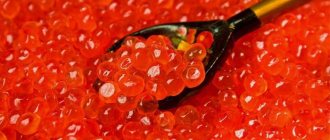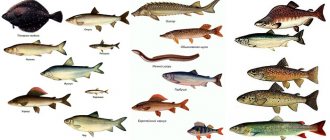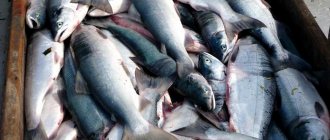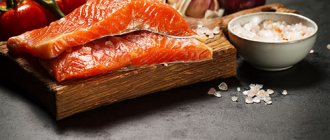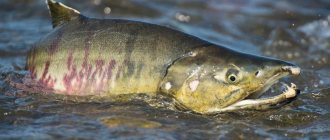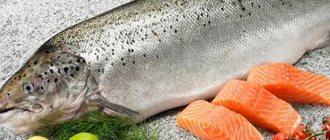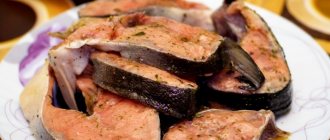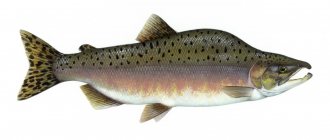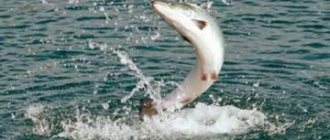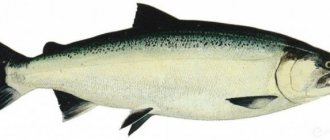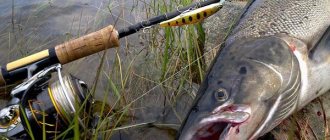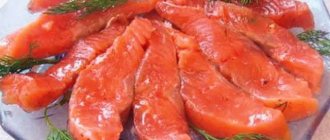Appearance of chum salmon and difference from pink salmon
Unscrupulous sellers deliberately replace chum salmon with pink salmon, since the latter is cheaper, fattier, although no less healthy. Often people who do not understand the topic of fish species and families in detail confuse these two species. That is why when buying, doubts arise and questions arise whether the sellers are deceiving. When cut, the fillet parts are difficult to distinguish, but possible.
Chum salmon is larger in volume: it reaches 1 m in length, with a weight of almost 15 kg. This is a common fish, and ranks confidently in second place in population among its family. The meat of this fish is less calorie and fatty. It looks unremarkable: with a silver color, which is complemented by pink-crimson stripes during the spawning period.
Pink salmon is 25 cm shorter than its relative. This is primarily due to the fact that adult individuals often die after spawning without having time to grow to a large size. A peculiarity has also been noticed that they grow faster. It has spots on the body and pronounced sexual characteristics.
The chum salmon has a highly developed sense of homeland. To spawn, she returns to the place where she was born. Pink salmon, on the other hand, do not have such an instinct, so each time they choose a new place for breeding.
Red salmon
Sockeye salmon is smaller in size and weight than chum salmon. It mainly feeds on small but very fatty calanid crustaceans, colored red. It is the coloring pigment of crustaceans that makes sockeye salmon meat very red. It has the reddest meat of all salmon. When salted, it does not fall apart and does not lose its appearance.
This fish has one amazing feature: when it enters fresh waters to spawn, irreversible processes . The body becomes bright red, the head acquires a green tint, the jaws elongate, become like a beak with teeth, and the scales begin to shine. All these are signs of slow death. Sockeye salmon is called “krasnitsa” due to its bright red body color.
Delicious recipe! Pumpkin Frankenstein for Halloween
Krasnitsa is used to prepare both everyday dishes and dishes that can surprise any gourmet.
What are chum salmon and pink salmon
Chum salmon and pink salmon are representatives of the Salmon family. They make up 80% of the Salmon catch and are in demand on the market.
Chum salmon is one of the varieties of Pacific salmon, with a characteristic elongated body shape and shiny silver color. There are 2 types: “summer”, which lives in northern latitudes, and “autumn”, which lives in the southern part of the world. They differ in length: representatives of the north are 20 cm shorter than their relatives from the south.
Balyk is prepared from this fish, canned, salted, dried, smoked, and frozen. In addition to meat, its most valuable caviar is used as food. In our country it is freely available and anyone can purchase it.
Pink salmon, or pink salmon, is also a species from the Salmon family. This fish lives in cold waters, the temperature of which does not exceed 15°. The most optimal temperature for the life of an individual is 10°, and at 26 it dies. It prefers to eat high-calorie foods, so pink salmon meat is fattier and higher in calories. After only 1.5 years, mature individuals go to spawn to lay eggs and die. The fry, having hatched, remain for some time in a secluded house, waiting until they grow up so that the current carries them into open sea waters.
Chum salmon - sea or river fish
Chum salmon is particularly valuable because it does not breed and does not live in captivity. When buying a real specimen in a store, you can be sure that it was grown in natural conditions and did not use any artificial growth stimulants.
This species has a wide habitat: it is found both in the oceans and in seas and rivers. In terms of prevalence, this fish has no equal among Salmonids. The quality of fish meat directly depends on the diet of the individual. The catches in Russia are small, which also determines the corresponding price.
This is a fish that does not have a specifically defined habitat. Large flocks enter river waters for spawning, while others, on the contrary, melt from the river into the seas and oceans. During such travels, their color changes - it becomes darker and stripes appear.
The large, wide and massive tail is primarily intended for digging holes in which eggs are laid. Some pits reach 2 meters!
Coho salmon fish: photo and description
Coho salmon are a fish that live along the Pacific coast. The individual has silvery scales, which is why it is sometimes called “silver salmon.” The average life expectancy is about 5 years; it is noteworthy that only at the age of 4 years does the fish reach sexual maturity, and before that it lives in rivers and feeds on plankton and small fish.
To spawn, the fish goes into rivers and winters in the seas and oceans. In Russia, it is most often possible to catch coho salmon up to 90 cm in length and weighing no more than 7 kg. North American individuals are generally slightly larger (the average length of fish there is more than a meter, and the weight of large individuals is from 14 kg).
Differences between chum salmon and pink salmon
There are several points on which these types differ:
| Criterion | ||
| 80-100cm, elongated body. | Up to 75cm, with a hump during spawning. | |
| Light gray, silver, with stripes during spawning. | Gray-blue, and during spawning – gray with a yellow-green belly. | |
| Lighter, brighter, juicier and larger. | Slightly smaller in size, with thin walls and darker. | |
| 4. Spawning site | Place of birth, quiet rivers. | The first place I liked. |
| Dietary, tender, full of vitamins and minerals. | Fatty and filling. Calorie content – 140-150 kcal. |
They are equally amenable to heat treatment, and excellent dishes are obtained, even with a minimum of spices and additives. A universal product that you can experiment with: processing methods, side dishes and spices. You can get an appetizer, salad, pie, first or second course - you are not limited in your imagination.
When choosing a fillet, pay attention to the shade - pink salmon is faded pinkish. It is the easiest to distinguish among other representatives of the family, and chum salmon has a bright, juicy pink color. Do not buy pickled or frozen, as the shades may be the same due to processing.
Differences in appearance
Chum salmon have a light gray color that darkens on the way to spawning. Crimson stripes also appear in the tail area - this is a sure sign that the individual is heading to the breeding site.
Pink salmon got its name because of the hump that appears on males during spawning. This distinctive sign distinguishes these fish well from others. It also has small scales and dark spots all over its back and tail. The inhabitants of the ocean have a gray color with a blue tint, and during reproduction the color changes to specifically gray with a yellow-green tint on the abdomen.
The caviar also varies: chum salmon eggs are larger, brighter in appearance, with a dense shell. Accordingly, caviar of the second type is smaller, approximately 1 mm in diameter, darker in color and with thinner walls. However, both types have wonderful taste, are equally beneficial for the body and are recommended for consumption. The rich composition of minerals, trace elements, and proteins is what distinguishes the caviar of these fish!
Differences in composition
Chum salmon meat and caviar are considered a more fat, tender, healthy and dietary product. This also affects the price. Based on taste, everyone chooses what they like. And yet, people more often make a choice in the direction of this fish. It contains vitamins E, C, PP, B1 and B5. Caviar contains a third of vegetable protein, which is completely absorbed by the human body. . In contrast, there are supporters of pink salmon who consider it a useful and relatively inexpensive product.
The differences in composition are insignificant. The differences are expressed in the mineral and vitamin composition. Chum salmon has a predominance of B vitamins, while its smaller brother has a richer mineral composition. The latter contains a storehouse of iodine and fluorine, as well as manganese. Children are required to take a course of fish oil so that vitamin D is better absorbed. The caviar of both representatives of Salmon, their meat or extracted fat are suitable for this. This is a source of polyunsaturated acids, amino acids, which are not found in any other food product.
Red fish is a very valuable product in cooking because of its taste and nutritional qualities. Salmon is on the menu of every self-respecting restaurant owner. The number of red fish individuals is huge. To choose the one you need, you need to learn about the taste properties and basic characteristics of the most diverse of them.
Characteristics of chum salmon
Chum salmon is a fish of the salmon family, common in the Pacific Ocean. Occupies an important place in industrial fishing. The large scale of chum salmon fishing is explained by the wide habitat:
- North American and Asian Pacific coasts;
- Bering and Okhotsk seas;
- rivers of Siberia: Lena, Yana, Indigirka and Kolyma.
Chum salmon, which enters the rivers in the summer from July to August, reaches eighty centimeters. The winter one, which enters rivers in the fall and most often lives under the ice, grows up to one meter. Sakhalin chum salmon are on average slightly more than half a meter (61–65 cm) and weigh up to 3 kg. Fish spawn in the cool, quiet waters of America, Korea, Primorye and Japan in early to mid-autumn. Chum salmon, which live in southern waters, leave for spawning later.
The fish lays large eggs in a knocked-out hole, which, after fertilization, are covered with gravel. The mounds that the fish forms sometimes reach a height of three meters and a width of 2 meters. Inside such a mound, fry develop and go to sea in the spring.
After laying eggs, the chum salmon dies. Energy-intensive migration to the spawning site, protection of eggs from predators, as well as exhaustion of females and males are the main reasons for the death of fish. The average chum salmon, under good living conditions, lives for more than five years.
Chum salmon meat contains a lot of high quality protein, which makes up most of the weight of the fish; fat accounts for 5% of the total composition, the rest is water. Therefore, cooked chum salmon meat is a bit dry. Fish contains many vitamins and microelements.
Coho salmon - what is it?
Large coho salmon are also called “silver salmon” or “white fish” because of their characteristic silvery scales. It lives in the American waters of the Pacific Ocean, from the coast of Kamchatka to the north-west of the Sea of Okhotsk. A small number of individuals can be found off the coast of Hokkaido and Sakhalin. The length of large coho salmon reaches 80 cm and weight – 7 kg. Commercial coho salmon caught off the coast of Kamchatka usually weighs no more than 4 kg and is up to 60 cm long.
Alaskan coho salmon grow much larger. It lays small burgundy or red caviar late, from September to March, most often under ice and only in rivers. Spawning females and males are painted a bright crimson color. The fry go to sea after two years of living in rivers. And those who preferred river life become dwarf.
Heat-loving coho salmon live very little in the sea. Having become sexually mature in the third or fourth year, coho salmon return back to the rivers.
Kamchatka individuals come in three types:
- summer
- spawn in early autumn; - autumn
- at the end of autumn and beginning of winter; - winter
- spawning from December to February.
Meat contains B vitamins and many microelements; it is considered dietary. Therefore, it is recommended for children and elderly people. Coral-colored meat is salted or stewed in sauce. But due to the small number of individuals in nature, this fish has a large price category.
Main differences
They differ from each other in that salmon unites a whole family and several genera of fish, while salmon is a specific species. Salmon is often called salmon, which does not contradict the classification of fish established by biologists. But it is incorrect to call any representative of salmon salmon, since it is only a separate species.
Salmon are found in the waters of the Atlantic and Pacific Oceans, as well as in northern freshwater bodies.
Salmon spawning occurs at the end of September or October. In regions with warmer climates, breeding begins in October and continues through January inclusive. Spawned individuals most often lose weight and lose strength, which leads to inevitable death. Therefore, most salmon spawn only once in their lives. With the arrival of spring, fry begin to emerge from the eggs. They can remain in river water for 5 years. During this time, each fry grows to approximately 20 centimeters in length, and the speckled color changes to silver-white scales. Then the matured juveniles move from the river element to lakes, seas and oceans, where as a result of active feeding they gain weight.
In addition to salmon, the salmon family includes many more species of fish, which in everyday life are called “red fish”. Here is a description of some of them.
Salmon
It is also called lake or Atlantic salmon. Some specimens can reach half a meter in length and weigh up to several tens of kilograms. You can see what salmon looks like in the presented photo. The body is covered with silvery scales, and the fat is distributed over the entire surface of the carcass. Salmon meat does not change color as a result of heat treatment. The life cycle does not exceed 13 years.
Trout
It is much smaller in size compared to salmon. On average, the length of one fish does not exceed 30 centimeters, and the average weight is 0.5 kg. Trout has a thinner fat layer, so it is lower in calories. The meat is either white or slightly yellow or red in color.
Coho salmon
This fish is also quite large in size: it can grow up to 98 centimeters and reach a weight of up to 15 kilograms. It is found in Japan and America, where it is called silver salmon because its scales are bright silver in color. And its old Russian name is white fish.
Chinook
Another name for this species of salmon is king salmon. The average length of its body is 90 centimeters. It is distinguished from other species of the salmon family by a larger number of gill rays. In total there are more than 15 of them.
One of the most common representatives of the salmon family. The maximum body length that was officially recorded was 1 meter, and the weight was almost 16 kilograms. Among all salmon species, chum salmon has the widest range. Lives on average 7 years.
Red salmon
This type of salmon has a brighter color. On average, they grow up to 80 centimeters in length, their weight ranges from 1.5 to 3.5 kilograms. Spawning occurs mainly in lakes, in places where springs emerge. Sockeye salmon also differs from other salmon fish in the color of its flesh. The photo shows that it is not pink, like the others, but bright red.
Pink salmon
This is the most widespread fish species among salmon. It is easy to distinguish from the rest, since pink salmon is the smallest of all species of the salmon family. The average specimen reaches a mass of about 2 kilograms.
Chum salmon and coho salmon - advantages
Residents of the Far East and Kamchatka are real connoisseurs of red fish. They love coho salmon for the extraordinary taste characteristics of the meat. But for people who are less knowledgeable about salmon fish, it is quite difficult to distinguish the benefits of chum salmon or coho salmon.
If we consider the properties and composition of substances of both fish, they are approximately the same. All salmon are rich in vitamins and minerals necessary for the human body.
Delicacy coho salmon meat is quite expensive. Juicy meat, slightly bitter, is included in the fish menus of popular restaurants around the world.
It is worth remembering that this fish is very fatty, so it should be consumed carefully by people with stomach and digestive problems.
Chum salmon is very healthy and at the same time cheaper than coho salmon. There is still no way to breed this fish in captivity. This is the reason for 100 percent confidence in the absence of antibiotics and other chemical elements in chum salmon meat to accelerate growth.
Chum salmon is better suited for the process of losing weight, since its energy value is slightly less than that of coho salmon. It is 125 kcal. The calorie content of coho salmon, in contrast to chum salmon, is 20 kcal more, which allows it to be considered fatter.
It is very difficult to judge the taste qualities of each fish objectively. For some, one type of salmon will taste bitter, for others it will be dry, for others it will be too fatty. But in world culinary practice, coho salmon is much tastier. He is considered to have the best taste. Its bright red meat is juicy and very tender.
Next comes chum salmon. Popular among Russians, the least fatty and with a lot of bones, pink salmon has a small price difference with chum salmon. Therefore, it is better to buy chum salmon, which, unlike pink salmon, is caught in the wild and is not stuffed with various chemical nasty things. Quite recently, coho salmon also appeared on store shelves. If finances allow, then there will definitely be no regrets about purchasing this type of salmon.
Both types of fish can be fried or cooked into rich fish soup. But it’s better to steam or bake salmon.
The taste of fish depends on its freshness. The time of catching and the number of freezing periods greatly influence the quality of coho salmon and chum salmon. Unfortunately, it is now almost impossible to purchase high-quality fish.
Difference in taste
Of all the types of fish in the salmon family, salmon fish has the best taste, which has always been considered a gourmet product. Its meat has a balanced aftertaste, and caviar contains a large amount of vitamins and microelements beneficial to the human body. Steaks are prepared from it and tender fillets are made. Large bones are used to make delicious fish soup. Salmon meat is more juicy and tender; it is sold raw, smoked and salted, as well as canned.
Choosing the right one
To choose high-quality coho or chum salmon, you need to adhere to some rules.
- Shiny scales that fit tightly to the meat without spots or bruises are the main signs of a good fish. It is better not to take salmon with irregularities and bruises.
- When purchasing fresh fish, press on the surface. In fresh fish, the pit will quickly disappear. If this does not happen, it means that the storage conditions were violated.
- When buying a whole fish, you need to look at its eyes. For a quality product they should not be cloudy.
- The surface of the carcass should not be sticky. Ideally it is smooth and slightly damp.
By following all these rules, you can choose high-quality fish for preparing delicious dishes.
You can store chum salmon and coho salmon for no more than 4 days in the refrigerator. Salmon spoils very quickly at room temperature. Therefore, it is better to create cool conditions for fresh fish. For longer storage, the carcass must be frozen.
Fish is one of the most important products that must be present in every person’s diet; it contains a huge amount of protein, vitamins, macro- and microelements. The most popular are red fish, namely chum salmon, coho salmon, pink salmon, and sockeye salmon. They contain high concentrations of polyunsaturated acids, which protect the human body from many serious pathologies.
Comparative characteristics
Quite often you can hear pink salmon referred to as salmon, believing that these definitions are completely interchangeable. Meanwhile, this is not exactly the same concept. Salmon is a separate genus of fish; it includes chum salmon, as well as sockeye and chinook salmon, and pink salmon, the latter being considered the smallest of all species. The length of the carcass almost never exceeds 60-75 cm, and the weight of the fish is approximately 1.5-2.5 kg.
The fish got its name thanks to the hump that “decorates” the back of the male during the mating season. A characteristic feature of pink salmon is its large, light, almost white mouth, as well as the absence of teeth on the tongue. This fish has small oval dark spots on the carcass and a V-shaped tail.
Compared to other fish of the salmon family, pink salmon grows and gains weight much faster than others. This is largely due to the fact that she eats quite high-calorie food - fry, as well as crustaceans and various small fish. In addition, accelerated growth is greatly influenced by the fact that pink salmon winter in waters where the average temperature does not fall below 5 degrees Celsius.
Unlike other salmon, pink salmon caviar is lighter in color and the shell is quite strong. In addition to caviar, fish pulp is widely used in cooking. It is quite dry, but nevertheless quite suitable for preparing a variety of dishes, as well as canning and pickling. Pink salmon is exceptionally healthy: it contains quite a lot of Omega fatty acids, as well as vitamin PP.
Pink salmon
Pink salmon caviar
Summarizing all of the above, we can draw the following conclusions.
- Pink salmon is one of the most common representatives of the vast genus of salmon; in science it is called “Pacific salmon”. It is not entirely correct to say that pink salmon is salmon, since salmon is a collective term that includes many different fish.
- Pink salmon differs from other salmon species in its relatively small size, certain external features, and wider habitat.
It is worthwhile to dwell separately on the differences between pink salmon and chum salmon; these are the subspecies of red fish that are most popular on our shelves, they account for 80-85% of the total catch of fish of this species. Chum salmon in nature occurs in summer and autumn. The summer fish lives in the northern regions, and the second - in the southern regions, while the autumn fish is much longer than the summer fish. This representative of salmon is characterized by a keen sense of its homeland: it spawns in the place where it was born.
Pink salmon prefers to live in fairly cool waters: its usual temperature is 15 degrees; in hotter climates it simply dies. In terms of calorie content and concentration of polyunsaturated acids, pink salmon is significantly superior to chum salmon. Unlike the latter, for spawning it always selects more and more new places, as a rule, these are rivers with large pebbles at the bottom. After birth, the fry hide in stone burrows for some time, and then swim out into the water column, from where they are carried into the ocean by a fast current.
Let's look at other differences between these types.
Chum salmon
Red salmon
Length and weight
Chum salmon grow to approximately 1.5 m, while pink salmon are half the size. Moreover, the first one weighs 10-15 kg, and the second one is almost 10 times lighter. At the same time, pink salmon grows faster than chum salmon.
Appearance
Chum salmon has a rather unremarkable color with a distinct silvery tint, and at the time of spawning, pinkish spots appear on the body of the fish. Pink salmon has dark oval spots on the carcass; in addition, this fish has quite pronounced characteristics of the genus. Thus, males have a curved upper jaw, rather large teeth, and a hump grows on their back during the breeding season.
However, inexperienced consumers quite often confuse these two fish, which is sometimes taken advantage of by irresponsible sellers.
Habitat
Chum salmon lives and reproduces exclusively in its natural environment, which is why its pulp is very highly valued, since this fish grows without the use of all kinds of antibacterial drugs, hormones and various growth stimulants. At the same time, chum salmon can live in both salty and fresh water bodies; among all representatives of the salmon genus, it is characterized by the most extensive habitat zone.
Pink salmon prefers the seas and rivers of the northern hemisphere; in most cases, it is localized off the coast of the Pacific Ocean, as well as in the Arctic, while the fish constantly migrates from the seas to large rivers, and then back. Pink salmon living in the ocean are distinguished by a slightly bluish or light green back, pronounced silver spots on the sides and a snow-white belly, and when this fish returns to its native fresh water bodies, the belly becomes yellowish.
The nutritional value
Consumers have been debating for quite some time about which fish is better and tastier - chum salmon or pink salmon, and cannot come to a consensus. This is not surprising, because both fish are extremely nutritious and healthy. Both types are classified as fatty varieties; they contain very high concentrations of fatty acids and microelements necessary for health. However, pink salmon has a slightly more high-calorie pulp: 100 g of product contains about 145-150 kcal, the fillet is fattier, its consistency is quite dense, and the color is pale pink.
Chum salmon fillet is drier and not so fatty; this product is classified as dietary, its calorie content is only 125 kilocalories. At the same time, the fish contains more B vitamins than pink salmon, and the composition of minerals is much more balanced: quite high concentrations of iodine, fluorine, as well as cobalt, manganese and chromium have accumulated here.
Caviar
As for caviar, between chum salmon and pink salmon it differs quite significantly both in its appearance and chemical composition. Chum salmon caviar is slightly larger, the color is rich scarlet-orange. Pink salmon eggs are slightly smaller in diameter, but they are covered with a rather strong outer shell. The taste qualities of both fish are exceptionally high, but chum salmon contains much more protein, and in a form easily digestible by humans. Chum salmon caviar is considered more nutritious and healthy.
Features of salmon representatives
Chum salmon is considered one of the most common commercial fish of the salmon family in the world. Under natural conditions, there are two varieties of chum salmon: summer and autumn. The first species is an inhabitant of the northern part of the planet, the second is found exclusively in the south. The autumn chum salmon differs from the summer one not only in name, but also in size: it is much larger. It also differs in taste.
Chum salmon have an excellent memory of their birthplace and return there to spawn. This is a fairly large fish, reaching in some cases a weight of 15 kg and 1 meter in length. It has a soft, even silver color. During the spawning period, its body gradually darkens, pinkish stripes appear on it, and its teeth increase in size.
Chum salmon is a very nutritious fish, containing a significant amount of vitamin E, C, B vitamins, as well as micro- and macroelements such as phosphorus, chlorine, fluorine, potassium, iron, etc. It is a valuable source of protein (per 100 g fish contains about 19 g of protein).
ON A NOTE.
Chum salmon is considered a dietary fish and has tender, tasty meat. Since its fat content is low, we recommend using gentle heat treatment methods during its preparation: instead of frying, bake, stew, or add to soups. This type of salmon is also perfect for aspic, salting, smoking, and as a savory ingredient in salads.
Sockeye salmon is another representative of the salmon family. True, it differs from chum salmon in its much smaller size and not so impressive weight: on average, the fish reaches 30-40 cm in length and weighs 3 kg. The body of sockeye salmon is silver in color, oblong in shape, and has a rounded head without a pronounced jaw.
Sockeye salmon has an unusual feature: when entering spawning, its body sharply changes its color to bright red, its head becomes greenish, its jaw strongly stretches forward, becoming like a toothy beak, and its scales begin to shine. All this speaks of irreversible processes leading to death.
Regarding nutritional properties
, then sockeye salmon is not inferior to chum salmon in this regard, and in some aspects even surpasses it. For example, it contains a larger amount of protein - about 20 g per 100 product, a significant amount of phosphoric acid and fluorine. Sockeye salmon meat is an excellent antioxidant. By the way, this fish, unlike chum salmon, is very fatty and is perfect for smoking, preparing cold appetizers, and salting.
Delicious recipe! Meat roasting paper
How to tell the difference?
In conclusion, we will give a brief overview of the distinctive features of pink salmon from some other salmon in order to understand what the difference between these species is. Inexperienced buyers quite often purchase pink salmon instead of sockeye salmon. The flesh of the latter is fattier and contains more vitamins, so it is valued much higher, which is what unscrupulous sellers take advantage of, passing off pink salmon as its more expensive relative. The main difference between these two salmon is their size: pink salmon is at least two times smaller than sockeye salmon. However, there are exceptions, but very rarely.
The tail can tell a lot of interesting things about a fish: if there are fuzzy dark spots on its fin, then this is a pink salmon.
In addition, it has more delicate scales: if these two fish lie in front of you, then distinguishing one from the other will not be difficult. If there is only one fish in front of you, then you can try to count the number of scales in the very first row, located above the lateral line. Typically, in sockeye salmon their number does not exceed 145, while in pink salmon it varies from 170 to 210.
You can make your work easier: just select about a fifth of the length and multiply the number of scales in it by five, this accuracy is more than enough to determine what kind of fish is in front of you.
It is not at all difficult to distinguish pink salmon from fish such as coho salmon, although they are approximately the same in size. Coho salmon have a rather unique color: the head and back have a greenish tint, and the sides and belly are silvery-white. There are transverse stripes on the body, which, unlike pink salmon, are noticeable and located below the lateral line, and oval or triangular spots are visible between the stripes.
During spawning, the scales acquire a pronounced pink tint. Coho salmon meat is very tender and juicy, and this is another difference between the two salmon.
To learn how to distinguish a female from a male salmon, watch the following video.
Red caviar, especially recently, is considered a real delicacy. Unfortunately, few people think about the fact that this is not only a tasty product, but also healthy. Each salmon representative has its own caviar, which differs in some characteristics. Very interesting, what is the difference between chum salmon caviar and sockeye salmon caviar?
During the production process, preference is given to granular caviar, since this type of product is the most in demand. It is cleared of film using a special device, after which it is placed in a saline solution for half an hour. After this, it is filtered, preservatives are added and packaged in jars.
The finished product comes in 2 varieties:
- 1st grade prefers one type of caviar to be packaged. At the same time, all eggs should have the same color and the same size, and should also be easily separated from each other. Any foreign tastes and odors should be absent. This caviar contains no more than 4-5 percent salt.
- Grade 2 allows mixing of different types of caviar. It may be distinguished by the presence of foreign tastes and aromas and may contain up to 8% salt.
Chum salmon and sockeye salmon are bright representatives of the salmon family. Their caviar is absolutely different both in appearance and in the content of nutrients. In addition, they have completely different tastes and aromas.
Chum salmon caviar is different:
- Large eggs, about 6 mm in diameter, almost the same size.
- Orange in color, with red tints.
- Delicate taste.
- Relatively durable shell.
- Preparing cold appetizers and salads.
- It is mined in August and September.
Sockeye salmon caviar is characterized by:
- Quite small eggs, no more than 4 mm in diameter.
- Dark red color.
- The presence of a bitter taste and a pronounced aroma. Thanks to such qualities, she is considered unique.
- Caviar is harvested in June or July.
- Difficult to find for sale due to massive fishing.
Taste characteristics: which caviar to choose?
Sockeye salmon caviar has a rich flavor and is similar in taste to its meat. It is very tender and practically melts in your mouth.
Chum salmon caviar also has a bright creamy taste, and its characteristic feature is the presence of a delicate shell that easily bursts in the mouth with an interesting effect, from which a person receives great pleasure.
If we take the above as a basis, it turns out that:
- is a product that is suitable for almost any person who prefers seafood.
- – this is a product for everyone who is able to correctly evaluate its taste.
Therefore, which one to choose depends on the personal preferences of each person. As a rule, you can see chum salmon caviar on every holiday table, as it is more accessible, including in price.
Beneficial features
Both caviar contains a high concentration of useful substances, such as:
- Minerals: manganese, iron, calcium, potassium, folic acid, phosphorus.
- Fatty acids: Omega-3 and Omega-6, which optimize the functioning of the cardiovascular system. There are 13.8 grams of them in 100 grams of product.
- Vitamins: E, C, PP, B, A. All of them have a beneficial effect on the general condition of the body.
- Proteins that are easily absorbed by the body.
- A powerful natural aphrodisiac that increases potency in men and sexuality in women.
Despite this, sockeye salmon caviar is richer in iodine, which can positively affect the functioning of the thyroid gland, and chum salmon caviar has a higher content of fatty acids, which protect the human body from harmful effects.
Any caviar is characterized by the presence of substances that slow down the aging process, including chum salmon caviar and sockeye salmon caviar. In this regard, it should be noted their enormous nutritional value for the human body.
Calorie content
- The calorie content of chum salmon caviar is 250 kcal per 100 grams of product.
- The calorie content of sockeye salmon caviar is about 243 kcal per 100 grams of product.
In fact, their calorie content is the same and they differ only in the concentration of individual beneficial elements.
Despite the obvious benefits of this product, not all categories of people can eat it. For example, it is contraindicated for people:
- Suffering from swelling.
- For hypertension.
- Atherosclerosis.
- Coronary heart disease.
- With kidney problems.
As a rule, caviar contains a high concentration of salt, which also limits its consumption. It is recommended to eat it no more than once a week and no more than 2 teaspoons. In other words, it is enough to eat a couple of sandwiches in a week and the body will be replenished with all the missing vitamins and minerals.
For people suffering from obesity, there are also restrictions, since caviar is a high-calorie product.
Among other things, caviar of factory origin contains preservatives that cause significant harm to the human body. But, in this case, it is impossible to do without them. To protect yourself from these harmful components, it is better to prepare caviar at home yourself, if possible.
At the same time, it should be added that you should not get too carried away with red caviar. Extra grams eaten will not bring benefits to the body: the body will take as many useful substances as it lacks, and the rest is a waste of money. If you use it in moderation, there will be no harm.
Wild vs Farm
Article on the topic Cheap does not mean bad.
Choosing the most delicious white fish In appearance, such cheap fish is very different from imported fish, bright and fatty. It is explainable. The fact is that the Norwegians, as well as other salmon producers, raise them on farms. The fish are kept in the pools, they are fed very well, including food that slightly tints the meat. That's why salmon from Europe is so bright. And the white veins, although they make the fish meat very beautiful, still remain fat. Yes, fish, yes, relatively healthy, but still fat. Our fish are wild. We are just setting up its artificial breeding. And so far there is no farmed fish. Wild fish loses very much in appearance. It’s not as bright, it’s not as large, there aren’t nice slivers of meat that flake off when you bake or salt it. Murmansk and Far Eastern fish are much smaller. It may not be red at all, but pinkish or even gray (like pink salmon). Wild salmon meat is denser, there is practically no fat in it, it accumulates under the skin to warm the fish, and is not deposited as excess.
In fact, wild fish is much healthier than farmed fish. She ate not artificial food, but what she found in the sea, only natural products. She moved a lot, her muscles were well developed. And wild fish usually costs much more than farmed fish. Only in our country, due to the peculiarities of the organization of the fishing business, due to the underdevelopment of aquaculture, due to the fact that Western producers and their own importers greatly increased prices for salmon and trout, only here the opposite happened. And what is healthier is cheaper.
How much does caviar cost?
A jar of caviar weighing 145 grams will cost from 8 to 15 dollars.
Chum salmon caviar is truly a royal dish, as it is very tasty, and the absence of extraneous taste and aroma makes it desirable on every holiday table.
Fish is the most important product in the human diet. Its benefits have been proven for a long time. It contains vitamins, proteins, and minerals. The meat of red fish (chum salmon, pink salmon) is especially useful. It contains Omega-3 polyunsaturated acids, which slow down the aging process and protect the body from many diseases.
